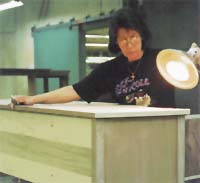Reprinted with permission from Modern Woodworking Magazine.
The time to catch imperfections or defects in a wood product is before that product reaches the finishing process. “Because the use of stain on wood makes even the slightest of scratches or chips visible, it becomes critical that a manufacturer have a series of nets to catch defects before they get stained,” said Don Barrett, resource manager at Councill Craftsmen.
Councill Craftsmen, located in Denton, NC, is a producer of high-end residential and office casegoods. The company employs a unique manufacturing philosophy that allows it to make all products to order. “We call it synchronous manufacturing,” Barrett said. “In order to have a reasonable lead time, we place our parts in bins. When the order is taken and the proper time to release the parts onto the production floor has been determined, we pull the parts out of the bin and send them to the assembly area.”
This is where the thorough inspection process begins. Before the parts are placed into the bin, they are visually inspected and measured for cut accuracy and for any wood defects or imperfections. When the part comes out of the bin, it is assembled. “Once the parts are assembled we inspect them again,” Barrett said. “Immediately after we have the pieces loaded onto the finishing line we inspect them once again.

Councill Craftsmen arms its inspectors with hand-held lights that allow for easier detection of imperfections.
Still, not satisfied, the company now uses a special fluorescent light manufactured by 3M to aid in defect detection as well. Although its use is on a trial basis, Barrett hopes to utilize the lighting system throughout the entire plant and not just in the inspection areas. “We were given an opportunity to test out the new lighting technology developed by 3M in May of last year and it has been very effective,” Barrett said. “The automotive industry uses these lights, which fit in a standard sized fluorescent lighting fixture, and has great results. Now 3M is trying them in the woodworking industry.
“3M is talking about bringing us more. We were hoping that the new lighting technology would allow us to discontinue the use of so many on-the-spot inspectors. Although the system has worked great, I don’t think we will ever be able to stop the amount of visual inspection we perform. Product quality is just too large an issue in this industry.”
Reprinted with permission from Modern Woodworking Magazine. Free subscriptions are available by completing an on-line Subscription Form.